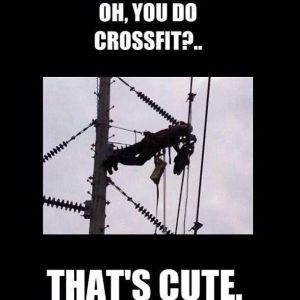In my ongoing training for the Ultra Beast, I have pushed myself to find tough events to test out my gear, my physical abilities, and my mental game beyond where I push myself in training. I had to cancel out of a 50K trail race, and found out that there would be a GORUCK Challenge and Light in Sioux Falls (my girlfriend’s hometown) and got a few of my teammates from the Blackshirt Spartans to sign up with me. Looking for a way to push harder, this seemed like the ticket. I had no idea how right that would be, how hard we would push, or how much more than we thought possible we would do.
Found the start point, met our Cadre (Cadre Rick), and started the welcome party. I was called up to demonstrate the Tunnel of Love and the 1-man buddy carry. Buddy carries, rushing drills, failing entirely at the dreaded Inchworm Pushup, then having to bear-crawl and crab-walk around the park.
We then had all of our food taken from us. (Word to the wise, ALWAYS have gatorade in your hydration pack. You will need the sugar.) We then moved out following Cadre, until we reached our first assignment.
We were given a time hack to have one team fill a sandbag while the other recovered a piece of information from a nearby landmark. We made the time hack, and moved off team-carrying the sandbag, heading for the battleship memorial.
We soon figured out getting people on the sandbag and switching them out on the move. At one point we had to be told of our remaining time/remaining distance by Cadre, indicating we needed to step it up, but overall the movement went very well. At several points we went through crowds outside bars, and I’ve got to hand it to Sioux Falls, this is the first city where I have ever gotten cheers.
We made it to our objective with 3 minutes to spare and were given time to eat, rest and take on water. During this time, Cadre asked us a number of historical trivia questions that would help us on our next movement. We got exactly one right.
When Cadre gave us the next objective and the time hack, several of the locals, who knew where we were going, responded with, “No way. We can’t do that!” We were then told that we could not use our pack straps, pack top handles, or the handles on the sandbag. Our one correct answer had earned us one ruck that could be put on.
We agreed that the flag bearer should get to wear the ruck, we were able to divide up everything that needed carried (with great difficulty) and we were off, but not nearly at the pace we needed. Cadre encouraged the team leader to get us better organized, and we started to pick up the pace. After awhile the man carrying the sandbag (around 90 pounds) started faltering, and I took it from him and handed off my ruck. I was impressed with how well I was able to carry the load, but I still started faltering before too long. By this time we had entered a residential area and were told no talking, hand signals only, so I couldn’t get anyone’s attention to switch out the weight, so I struggled on with it as well as I could. Schmitty came up next to me and gave an inquisitive thumbs up. I did my best to improvise a signal for “I’m freaking dying,” and he took the sandbag and gave me his ruck.
Speaking in whispers, Cadre gave us additional historical questions to earn back more ruck straps. The first few went to people struggling with two rucks. When no one volunteered for the next one, several of us nominated Schmitty, and the next one I jumped on.
I then caused us a little trouble. A female GRT behind me asked if someone could take her ruck, I turned and took it, but this caused some confusion in the lines and caused us to break formation. Cadre stopped the line, and explained to us that while my intentions of helping a teammate were good, I failed to communicate this with the rest of the team, and that little communication points like this will save your team’s ass. I appreciated this and several other points like this where he was willing to stop the movement, not to punish us for mistakes, but to teach us how we could do it better.
Just before daylight, I was named team lead and given a task that I thought impossible. Cadre selected a railroad tie that was something near 12×16″ and roughly 14′ long. I went to lift the end of it to see how heavy it was, and I couldn’t budge it on my own. Cadre asked what I thought, and I told him flatly that I didn’t think the team had enough left in them. He simply replied, “Yes, you do.”
That was the most brutal carry I have ever done. The first few minutes, my leadership was an absolute mess, but then I started figuring it out, ordering the team weight to be handed off to put someone new under the log, putting a weaker person as flag bearer to give us more muscle to work with, getting under it myself when someone needed out. When I was under the log, I couldn’t look around, so I told the flag bearer to be our eyes and direct us. We carried it in and out of several of the lookout points overlooking the falls.
We hit a point where unit cohesion was breaking down, we were dangerously close to losing control of the log, and several people told me later that they were close to walking away. I didn’t know what else to do, so I called out to Cadre, told him we couldn’t hydrate with so many of us needed under the log, and asked permission to take a break. He pointed to where he wanted the log, and we were given a short time to recover before getting it back up and taking it back where we had gotten it.
The last movement was getting back to our start point with two people designated as wounded, so we had two people carrying the wounded, and two (including me) carrying the wounded’s rucks in addition to their own. We would move about a block or two at a time, then switch out people under the wounded. At some point someone asked if they should take the extra ruck to put me in rotation under the wounded, and I replied that I didn’t think I could carry that far at a time. A few minutes later, we hit the inevitable point where the call goes up for a new carrier and no one steps up, so I handed off the ruck and picked up the wounded. I was able to go the required distance and traded off every other stop for the rest of the movement.
When we reached our destination, we were ordered into the water.
We did an unknown number of thrusters, and then were announced mission complete. A few hours to rest up and patch up, then back for the Light.
The light was very unusual, in that there were only four of us. The official rule is that there need to be five or the event will be cancelled, but Cadre offered for it to go ahead and we jumped on it. Welcome party similar to the night before, heading out on the Greenway trails, and again being given a sandbag carry. We struggled on with it as a 4-person carry, but it wasn’t really working with no one to trade out with, all of us on the carry. Eventually Schmitty gave me his ruck, threw the sandbag on his shoulders, and drove on. We absolutely annihilated our time hack, and were rewarded with being able to empty the sandbag.
Next challenge: One of the team is wounded in one leg, they can be carried or can hop on one foot, but if the left foot touches the ground there will be a penalty in flutter kicks. Each minute over the time hack will incur a penalty in flutter kicks.
I was chosen as wounded, and got to learn exactly how much being carried over someone’s shoulders sucks. We tried several different methods and benefited from several bets with the Cadre that if we stopped for flutter kicks or sang to a local I could walk a specified distance. We reached our objective more than 300 flutter kicks late and were given a reduced penalty.
We moved on with basic movement drills, and were given our final mission with me as team lead: You have 10 minutes to reach the top of a specified parking garage for helicopter extract. If you miss the chopper, you will be assigned one wounded and will have to make it the rest of the way out on foot. And you have just been ambushed so badly that you all lose your shoes.
I put Will, who knew the location, as flag bearer to show the way and we moved out. All seemed to be going well until I nudged one member of the team to move a little faster, and that pushed her past her mental limits. She started yelling that she wanted to quit, that I was being a jerk for telling her to go faster, pretty normal spaz out when we have hit our limit.
Between Cadre and the three teammates we were able to encourage her on, knowing we had missed the time hack and would have to carry her out of here, but better that than letting her quit when we had to be near the end.
As we approached the top level, Cadre made a comment of ,”Let’s go see if the helicopter is still here…”
“GORUCK Light Class 396, you are Mission Complete. The helicopter was always here. You just needed to make it here.”
It was an unusual end to an event, as two of us were tending to the blisters on our teammate’s feet, arranging who to send for a car to get her back to the start point, and Cadre giving us a short AAR on what could have been done better, that she needed to be more honest about what she needs to keep going, and that I as team leader need to be able to tell when I am dealing with pride putting a brave face over pain, and be able to work around it without making anyone feel that they aren’t doing their share.
I learned a lot at this event, and it is one of the few events in my history, while I performed far from perfectly, I think I did well.
We did what we thought was impossible.
Not yet, not ready quite yet, but HEAVY, I am coming for you…













